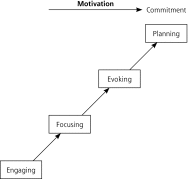Shared decision making and motivational interviewing: achieving patient-centered care across the spectrum of health care problems
- PMID: 24821899
- PMCID: PMC4018376
- DOI: 10.1370/afm.1615
Shared decision making and motivational interviewing: achieving patient-centered care across the spectrum of health care problems
Erratum in
- Ann Fam Med. 2014 Jul-Aug;12(4):301
Abstract
Patient-centered care requires different approaches depending on the clinical situation. Motivational interviewing and shared decision making provide practical and well-described methods to accomplish patient-centered care in the context of situations where medical evidence supports specific behavior changes and the most appropriate action is dependent on the patient's preferences. Many clinical consultations may require elements of both approaches, however. This article describes these 2 approaches-one to address ambivalence to medically indicated behavior change and the other to support patients in making health care decisions in cases where there is more than one reasonable option-and discusses how clinicians can draw on these approaches alone and in combination to achieve patient-centered care across the range of health care problems.
Keywords: concept formation; decision making, shared; motivational interviewing; nondirective therapy; problem solving.
Figures




References
-
- Institute of Medicine. Crossing the Quality Chasm: A New Health System for the 21st Century. Washington, DC: National Academy Press; 2001 - PubMed
-
- Robinson JH, Callister LC, Berry JA, Dearing KA. Patient-centered care and adherence: definitions and applications to improve outcomes. J Am Acad Nurse Pract. 2008;20(12):600–607 http://www.ncbi.nlm.nih.gov/pubmed/19120591 Accessed May 22, 2013 - PubMed
-
- Rathert C, Wyrwich MD, Boren SA. Patient-centered care and outcomes: a systematic review of the literature. Med Care Res Rev. 2012. http://mcr.sagepub.com/content/early/2012/11/18/1077558712465774.abstract Accessed Jun 15, 2013 - PubMed
-
- Braddock CH, III, Edwards KA, Hasenberg NM, Laidley TL, Levinson W. Informed decision making in outpatient practice: time to get back to basics. JAMA. 1999;282(24):2313–2320 - PubMed
-
- Dellasega C, Añel-Tiangco RM, Gabbay RA. How patients with type 2 diabetes mellitus respond to motivational interviewing. Diabetes Res Clin Pract. 2012;95(1):37–41 http://www.ncbi.nlm.nih.gov/pubmed/21899911 Accessed Jun 5, 2013 - PMC - PubMed
Publication types
MeSH terms
Grants and funding
LinkOut - more resources
Full Text Sources
Other Literature Sources
